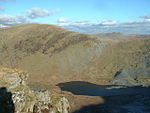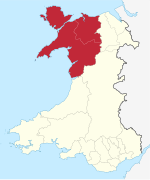Rhosydd quarry was a slate quarry in the Moelwyn mountains, northeast of Porthmadog in North Wales.
Small-scale working of the site began in the 1830s, but was hampered by the remote location, and the lack of a transport system to carry the slates to markets. The Rhosydd Slate Company was formed in 1853, and became a limited company in 1856. Transport was made more difficult by the attitude of the Cwmorthin quarry, through whose land the most obvious route to the Ffestiniog Railway ran. A solution was found in 1864, with the opening of the Croesor Tramway, to which the quarry was connected by one of the longest single-pitch cable-hauled inclines in Wales. Huge amounts of money were spent on development work, and the company, unable to make adequate returns, went into voluntary liquidation in 1873.
The quarry was auctioned in 1874, and the New Rhosydd Slate Quarry Company Ltd. was formed. Unlike its predecessor, the directors were all Welsh, and three-quarters of the shareholders were also from the local area. The quarry prospered for a while, but then profitability declined, and in 1900, a large section of the underground workings collapsed. The job of opening up new areas was spearheaded by Evan Jones, who nearly succeeded, but was hampered by a slump in the slate industry and the onset of the First World War, when the quarry was "non-essential" and was mothballed. It reopened in 1919, but was in a poor financial position, and was bought by members of the Colman family, better known for producing mustard. They kept it running until 1930, but failed to find markets for the finished product. It was mothballed until 1947, when it was sold, but new plans to reopen it failed, and the pumps were turned off in 1948, after scrapmen had removed much of the machinery.
Of the five slate veins in the region of Blaenau Ffestiniog, most of Rhosydd's output was extracted from the Old Vein. The workings started at the West Twll, where the rock outcropped, but the quarry soon developed into underground workings. A series of adits were constructed, to provide access as the mine got deeper, with the lowest at level 9. Trucks moved along this adit by attaching them to an endless chain, driven by a waterwheel. The mine eventually reached level 14, with rock raised by an internal incline to the level 9 adit. At its peak the quarry was one of the largest underground workings outside of Blaenau Ffestiniog, with 170 chambers.












